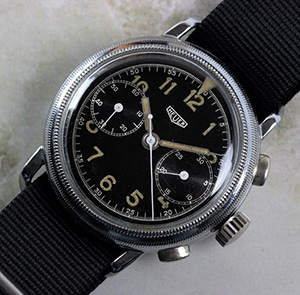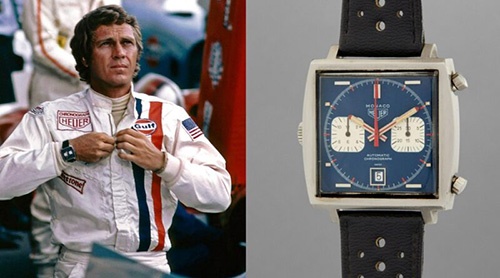The History of Heuer Watches
Discover how one of the most influential manufacturers in the world was created
30/01/2023
Today you will most likely recognise Heuer as TAG Heuer, but their history long pre-dates this partnership. This luxury Swiss watchmaker was created in 1860, when a 20-year-old Edouard Heuer first began making pocket watches in a shop on his family’s farm in St-Imier, Switzerland.
Known for their pioneering, ‘avant-garde’ techniques, it was Edouard who invented and patented the oscillating pinion in 1887, a component made up of a moveable shaft and two pinions, enabling the chronograph to operate effectively and with precision in the place of two large wheels. It is a mechanism still used by watchmakers today in chronographs. 1887 was such an imporant year for the development of both Heuer and the watch industry, that TAG Heuer recycled the date and used it as the name of their watch movement released in 2010.
A Heuer Autavia Skipper Ref 73464
The turn of the century played an important part in Heuer’s journey and influenced what they wanted their watches to achieve. The fast progression of science, medicine, industry, and transportation highlighted the modern age's reliance on precise timing. Heuer foresaw the important role accurate time-keeping would play in the future, and set to work innovating new and advanced watch technologies that would serve the fast-developing modern world.
In the decades prior, the industrial revolution redefined travel and transport, as roads, railways, canals, and skyways became key to the manufacturing and distribution of goods across Europe. As close observers of such developments, Heuer patented the ‘Time of the Trip’ in 1911, the first dashboard chronograph designed for use in automobiles and aircraft to indicate the time of day and journey duration. In 1933, this progressed with Heuer’s release of the ‘Autavia’, a dashboard time piece specifically used as a timer in cars and planes. During the Second World War, Heuer also manufactured pilot chronographs that were issued to the Luftwaffe, known as ‘Flieger’ Chronographs.

Second execution Flieger chronograph Reference 348 (1940)
Credit: On the Dash
The golden age of Heuer began in the 1950s. They grew their reputation as a leading motorsport watch manufacturer through their production of a variety of dashboard clocks and timers that were purpose-built to target the specific needs of drivers. Through the decade, their expertise expanded from simple dashboard clocks to all kinds of sport timing equipment for a wide range of sports, including skiing and sailing. An example of this is The Solunar that was issued in 1949, to allow fishermen and sailors to gather information by tracking the moon’s phases and monitoring tidal activity.
By the 1960s, Heuer had proven themselves to be one of the most high brow luxury sports watch brands, and famously became the first Swiss watchmaker to go into space in 1962. Worn by John Glenn, a Heuer 2915A stopwatch was used by the pilot of the Mercury Atlas 6 spacecraft during the first US crewed orbit of the earth. The original watch is now displayed at the Smithsonian Institution National Air and Space Museum.

John Glenn's Heuer 2915A stopwatch
Credit: TAG Heuer
Having completed their mission to create the first automatic chronograph movement, Heuer expanded its range in the 1970s, manufacturing the Daytona, Montreal, Silverstone, Calculator, Monza, and Jarama models, all powered by the Calibre 11 movement. During this period, Heuer became increasingly seen as the ultimate watch brand in the world of motorsport. Their reputation was enhanced when Steve McQueen famously wore the Monaco chronograph in the popular 1971 film, 'Le Mans', whilst their sponsorship of the Ferrari Formula One Team from 1971 to 1979 further embelished Heuer's affiliation with the sport. Heuer’s motorsport legacy lives on today, through TAG Heuer’s partnerships with Aston Martin and Red Bull Racing.

Steve McQueen wearing the Heuer Monaco in Le Mans (1971)
Credit: Iconic Alternatives
Edouard Heuer's great-grandson, Jack Heuer was the last member of the Heuer family to manage the manufacturer and was considered its most influential leader. However, 1982 brought about the Quartz Crisis (also known as the ‘Swiss Watch Crisis’), and Heuer CEO, Jack, was forced to sell his shares to new management. The new managerial team succeeded in resolving much of Heuer’s previous difficulties.
Continuing its strong links with motorsport (and Formula One in particular), in 1985 Heuer was sold to TAG (Techniques d’Avant Garde) manufacturers of ceramic turbochargers for Formmula One cars. Whilst TAG itself was jointly owned by Mclaren F1 team principal Ron Dennis, and his business partner Mansour Akram Ojjeh. Ojjeh was considered to be one of the wealthiest businessmen in the world at that time, and it was he who wanted Heuer to bear the TAG name. Thus, in 1986, the company was rebranded ‘TAG Heuer’, a name that continues to hold much prestige in the Swiss watch industry to this day.
Read more...
Are Watches a Good Investment?
Do you have a Heuer watch, or perhaps a Rolex, Omega, or Patek Phillipe watch that you are considering selling?
Please do get in touch with us today for a complimentary valuation.
We would love to hear from you.
0207 431 9445 / info@dawsonsauctions.co.uk.
